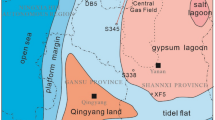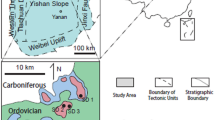Abstract
This paper takes the thick and widely distributed crystal dolomite of Xixiangchi Formation, Upper Cambrian in Southeastern Sichuan basin as an example, the reservoir characteristics and main controlling factors of crystal dolomite have been analyzed systematically, and the genesis and reservoir formation mechanism of crystal dolomite have been discussed. It shows that the main reservoir rocks of crystal dolomite include powder crystalline dolomite and finely crystalline dolomites, and the intercrystal pores and dissolved intercrystal pores are the main reservoir spaces, with few dissolved vugs and fractures developed in the reservoir. The pore structure analysis shows that the throats of crystal dolomite reservoir are mainly lamellar, reflecting a good configuration between pores and throats, medium- low porosity and low permeability, representing typical porous-type reservoir. Dolomitization analysis indicates that the dolomitization occurred in the penecontemporaneous or early diagenetic stage. The degree of dolomitization decreased gradually from the top to the bottom in each sedimentary cycle, and distribution of dolomite in the study area shows that the content of dolomites decreases from the west to the east, which reflects the degree of dolomitization weakening eastward. Combined with the geochemical research of crystal dolomite, the C and O isotope data reflect the same characteristics of seawater during the late Cambrian. It indicates that the dolomitization might be related to the seepage-reflux of seawater in the early time. Recrystallization played an important role in the genesis of the crystal dolomite, because most of crystal dolomites remain residual granular texture. The intercrystal pores formed by seepage–reflux dolomitization acted as superior seepage channels for the reservoir transformation, and the recrystallization adjusted the previous pores and made them better, while the karstification was the key to the dissolved pore formation.











Similar content being viewed by others
References
Ding X, Tan XC, Zhou Y et al (2012) Characteristics and genesis of reservoirs in Lower Triassic Jialingjiang Formation, central Sichuan Basin, China. J Chengdu Univ Technol (Sci Technol Ed) 39(3):269–276 (in Chinese with English abstract)
Feng ZZ, Pen YM, Jin ZK et al (2002) Lithofacies palaeogeography of the early Cambrian in china. J Palaeogeogr 4(1):1–12 (in Chinese with English abstract)
Gao SG, Hu ZM, An WG et al (2014) Distribution characteristics of dolomite reservoir pores and caves of Longwangmiao Formaiton gas reservoirs in the Sichuan basin. Nat Gas Ind 34(3):103–109 (in Chinese with English abstract)
Huang WM, Lin SG, Zhang CJ et al (2009) Reservoir characteristics and formation mechanism of the high quality Cambrian reservoirs in Sichuan Basin. Oil Gas Geol 30(5):566–575 (in Chinese with English abstract)
Jia P, Li W, Lu YZ et al (2016) Carbon and oxygen isotopic compositions and their evolution records of the Xixiangchi group in sedimentary sequence of central- southern Sichuan basin and their geological implications. Geoscience 30(6):1329–1338 (in Chinese with English abstract)
Jia P, Li W, Li M et al (2017a) Characteristics of carbon and oxygen isotopes and their significance of the Cambrian Xixiangchi Group carbonate rocks in eastern Sichuan basin. J Palaeogeogr 19(3):503–512 (in Chinese with English abstract)
Jia P, Li M, Lu YZ et al (2017b) Sequence stratigraphic subdivision and establishment of sequence stratigraphic framework in the Cambrian Xixiangchi group of Sichuan basin. Geol Sci Technol Inf 36(2):119–127 (in Chinese with English abstract)
Jiang ZB, Wang XZ, Zeng DM et al (2009) Constructive agenesis and porosity evolution in the Lower Permian Qixia Formation of Northwest Sichuan. Geol China 36(1):101–109 (in Chinese with English abstract)
Jin MD, Zeng W, Tan XC et al (2014) Characteristics and controlling factors of beach-controlled karst reservoirs in Longwangmiao Formation, Moxi-Gaoshiti area, Sichuan Basin, NW, China. Pet Explor Dev 41(6):650–660
Jing P, Xu FG, Xiao Y et al (2016) The bank facies distribution of upper Cambrian Xixiangchi Formation in the southern area of central Sichuan basin. J Northeast Pet Univ 40(1):40–50 (in Chinese with English abstract)
Keith ML, Weber JN (1964) Carbon and oxygen isotopic composition of selected limestones and fossils. Geochim Cosmochim ACTA 28:1787–1816
Li TS (1992) The characteristics of sedimentary rock and reservoir of oil and gas of Cambrian system in Sichuan basin. Miner Petrol 12(3):66–73 (in Chinese with English abstract)
Li W, Yu HQ, Deng HB (2012) Stratigraphic division and correlation and sedimentary characteristics of the Cambrian in central-southern Sichuan Basin. Pet Explor Dev 39(6):681–690 (in Chinese with English abstract)
Li L, Tan XC, Zhao LZ et al (2013) Prediction of thin shoal-facies reservoirs in the carbonate platform interior: a case from the Cambrian Xixiangchi group of the Weiyuan area, Sichuan basin. Pet Explor Dev 40(3):334–340 (in Chinese with English abstract)
Li WZ, Zhou JG, Zhang JY et al (2016) Main controlling factors and favorable zone distribution of Xixiangchi Formation reservoirs in the Sichuan basin. Nat Gas Ind 36(1):52–60 (in Chinese with English abstract)
Li YL, Wu FR, Liu DJ, et al. (2014) Distribution rule and exploration prospect of the Longwangmiao Fm reservoirs in the Leshan-Longnüsi Paleouplift, Sichuan Basin. Nat Gas Ind 34(3):61e66 (in Chinese with English abstract)
Liu H, Tan XC, Li L et al (2011) Characteristics and main controlling factors of porous carbonate reservoirs: a case from the Jia 5 Member of the Jialingjiang Formation, Southwest Sichuan Basin. Pet Explor Dev 38(3):275–281 (in Chinese with English abstract)
Liu SG, Song JM, Zhao YH et al (2014) Controlling factors of formation and distribution of Lower Cambrian Longwangmiao Formation high quality reservoirs in Sichuan Basin, China. J Chengdu Univ Technol Sci Technol Ed 41(6):657–670 (in Chinese with English abstract)
Luo CY, Zhang F, Wang XZ et al (2009) The effect of diagenesis on reservoirs in Feixianguan Formation in in northeast Sichuan basin. J Oil Gas Technol 31(5):182–189 (in Chinese with English abstract)
Major RP, Lloyd RM, Lucia FJ (1992) Oxygen isotope composition of Holocene dolomite formed in a humid hypersaline setting. Geology 20:586–588
Song WH (1996) Research on reservoir formed condition of large-medium gas field of Leshan-Longnvsi palaeohigh. Nat Gas Ind 16(supple):13–26 (in Chinese with English abstract)
Tang H, Tan XC, Liu H et al (2014) Genesis and dolomitization of “Khali” powder crystal dolomite in Triassic Jialingjiang Formation, Moxi gas field, central Sichuan Basin, SW, China. Pet Explor Dev 41(4):504–512
Tian YH, Liu SG, Zhao YH et al (2014) Diagenesis of Lower Cambrian Longwangmiao Formation reservoirs in central area of Sichuan Basin, China. J Chengdu Univ Technol Sci Technol Ed 41(6):671–683 (in Chinese with English abstract)
Veizer J, Bruckschen P, Pawellek F et al (1997) Oxygen isotope evolution of Phanerozoic seawater. Palaeogeogr Palaeoclimatol Palaeoecol 132:159–172
Wang XZ, Hou FH, Huang SJ et al (1997) The formation and evolution of reservoir in Sinian Dengying formation, Ziyang area, Sichuan basin. J Mineral Petrol 17(2):55–60 (in Chinese with English abstract)
Xu CC, Yang YM et al (2014) Accumulation condition and enrichment patterns of natural gas in the Lower Cambrian Longwangmiao Fm reservoir of the Leshan-Longnvsi paleohigh, Sichuan basin. Nat Gas Ind 34(3):1–7 (in Chinese with English abstract)
Yang W, Wei GQ, Zhao RG et al (2014) Characteristics and distribution of karst reservoirs in the Sinian Dengying Formation, Sichuan basin. Nat Gas Ind 34(3):55–60 (in Chinese with English abstract)
Yang XF, Wang XZ, Yang YM et al (2015) Diagenesis of the dolomite reservoir in Lower Cambrian Longwangmiao Formation Formation in central Sichuan basin. Geol Sci Technol Inf 34(1):35–41 (in Chinese with English abstract)
Yang XF, Wang XZ, Tang H et al (2016) Reservoir characteristics and main controlling factors of the Longwangmiao Formation in the Moxi area, central Sichuan Basin, China. Arab J Geosci 9:217
Yang XF, Wang XZ, Tang H et al (2017a) The Caledonian paleokarstification of Longwangmiao Formation, Lower Cambrian in the central Sichuan basin, China. Carbonates Evaporites 32(3):325–335
Yang XF, Tang H, Wang XZ et al (2017b) Dolomitization by Penesaline sea water in Early Cambrian Longwangmiao Formation, Central Sichuan basin, China. J Earth Sci 28(2):305–314
Yao GS, Zhou JG, Zou WH et al (2013) Characteristics and distribution rule of Lower Cambrian Longwangmiao grain beach in Sichuan Basin. Mar Origin Pet Geol 22(3):1–7 (in Chinese with English abstract)
Zhang GY, Xu SQ, Jiang XG et al (2008) Gas favorable area evaluation of the Leshan—Longnusi Sinian palaeouplift. Nat Gas Ind 28(S1):19–21 (in Chinese with English abstract)
Zhao AW, Tan XC, Li L et al (2015) Characteristics and distribution of grain banks in the Cambrian Xixiangchi group of Sichuan basin and its adjacent areas. J Palaeogeogr 17(1):21–32 (in Chinese with English abstract)
Zhou JG, Xu CC, Yao GS et al (2015) Genesis and evolution of lower Cambrian Longwangmiao Formation reservoir, Sichuan Basin, SW, China. Pet Explor Dev 42(2):158–166 (in Chinese with English abstract)
Zhu GY, Zhang SC, Liang YB (2006) Formation mechanism and distribution prediction of high-quality marine reservoir in deeper Sichuan Basin. Pet Explor Dev 33(2):161–165 (in Chinese with English abstract)
Acknowledgements
This research was supported by PetroChina Innovation Foundation (No. 2018D-5007-0105), Open Fund of State Key Laboratory of Oil and Gas Reservoir Geology and Exploitation (Chengdu University of Technology) (No. PLC20180304), open fund of Shandong Provincial key laboratory of Depositional mineralization (No. DMsMzO1TO35) and scientific research starting project of SWPU (No. 2017QHZ005).
Author information
Authors and Affiliations
Corresponding author
Additional information
Publisher's Note
Springer Nature remains neutral with regard to jurisdictional claims in published maps and institutional affiliations.
Rights and permissions
About this article
Cite this article
Yang, X., Huang, Z., Wang, X. et al. Origin of crystal dolomite and its reservoir formation mechanism in the Xixiangchi Formation, Upper Cambrian in Southeastern Sichuan basin. Carbonates Evaporites 34, 1537–1549 (2019). https://doi.org/10.1007/s13146-019-00499-y
Accepted:
Published:
Issue Date:
DOI: https://doi.org/10.1007/s13146-019-00499-y




